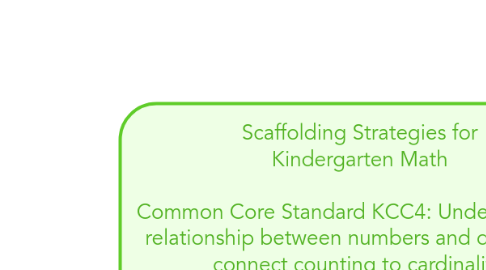
1. Key Factors:
1.1. Most strategies that benefit students with specific readiness levels or learning disabilities are actually beneficial for all learners and it is crucial for teachers to differentiate in order to reach everyone in class. Because everyone learns differently, its important to use a combination of approaches and methods to keep things interesting, engaging, fun and continuously changing. Most of my students are beginner ELLs as well as below grade level so these scaffolding strategies will help them to meet the following objectives.
2. Objective A. When counting objects, say the number names in the standard order, pairing each object with one and only one number name and each number name with one and only one object.
2.1. Big Ideas: Counting objects to demonstrate one-to-one correspondence.
2.2. Scaffolding Strategies:
2.2.1. Examples: Use real objects like counting manipulatives to demonstrate concept and allow students to work hands on
2.2.2. Visual Aids: Use number /dot lashcards that have the numeral and corresponding amount of dots; read stories where students can count pictures one by one in the story; play You Tube counting songs/videos
2.2.3. Handouts: Provide worksheets for students to work on individually which can also be used as sumative assessments
2.2.4. "I do, you do, we do" then do it individually
3. Objective B. Understand that the last number name said tells the number of objects counted. The number of objects is the same regardless of their arrangement or the order in which they were counted.
3.1. Big Ideas: Final number said = total quantity; Order of arrangement doesn’t affect total quantity.
3.2. Scaffolding Strategies:
3.2.1. Examples: Use real objects like counting manipulatives to demonstrate concept and allow students to work hands on
3.2.2. Visual Aids: Show objects arranged in various ways and have students count to realize the quantity remains the same each time
3.2.3. Handouts: Provide worksheets for students to work on individually which can also be used as sumative assessments
3.2.4. "I do, you do, we do" then do it individually
4. Objective C. Understand that each successive number name refers to a quantity that is one larger.
4.1. Big Ideas: Understanding the plus 1 sequence of adding onto existing quantities to increase the quantity .
4.2. Scaffolding Stategies:
4.2.1. Examples: Use real objects like counting manipulatives to demonstrate concept and allow students to work hands on
4.2.2. Visual Aids: Show number flashcards and pictures of objects with +1 more to compare the number with more being the bigger quantity
4.2.3. Handouts: Provide worksheets for students to work on individually which can also be used as summative assessments
4.2.4. "I do, you do, we do" then do it individually
